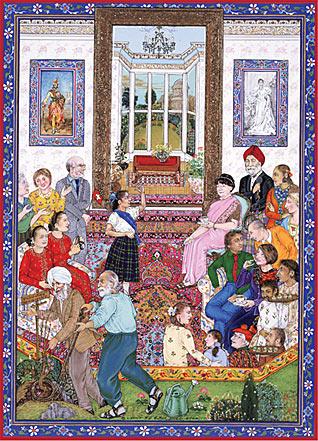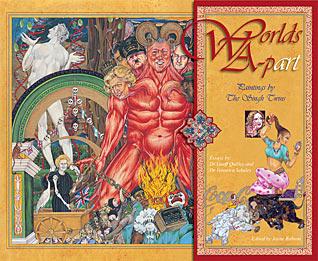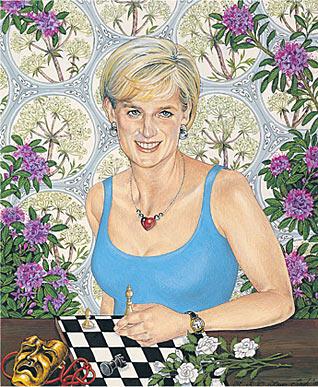Art
WORLDS A-PART
Paintings by The Singh Twins
Reviewed by Laurie Bolger
WORLDS A-PART: PAINTINGS BY THE SINGH TWINS. Published by Twin Studio, U.K., 2005. 80 pages. Price: £15.00
This work brings together some of the major commissioned projects and series of paintings Amrit and Rabindra Kaur Singh completed since their first book, Twin Perspectives, was published in 1999. Since then, the Singh Twins, as these British-born and based identical sisters are known, have enlarged their vision of popular culture, society, media and politics, through a reinterpretation of a wide range of historical paintings that embody traditional art forms.
In their Introduction, the Twins discuss the significance of the book's hyphenated title, which connotes both separateness and integration.
They feel it reflects the Occidental predilection for equating the West with modernity and the East with tradition, giving a superior value to the former. Their art is an attempt to oppose this tendency, by demonstrating the continued relevance of tradition and non-Western values, while nonetheless celebrating opportunities for intercultural exchange.
The Foreword to Worlds A-part was written by two representatives of the City Gallery in Leicester, England, which not only supported the publication of this book, but also exhibited the Twins' paintings in a show, "Past-Modern," in mid-2005. It discusses the Twins' unique presence in the British contemporary art world and the intercultural connections engendered by their work.
Two essays precede the paintings. The first was written by Dr. Geoff Quilley, Curator of Maritime Art at the National Maritime Museum in Greenwich, England. He feels the Twins' "Past-Modern" art moves beyond the constrictions of Modernism, as it is a collaboration between two women that not only honors traditional ways, but also evidences a high degree of social and political engagement. He lauds their acute awareness of both British and Indian cultures, and use of images that change meaning depending on their context. For instance, a white elephant symbolizes compassion to an Eastern viewer, but signifies wastefulness in a Western setting.
The second essay was authored by Dr. Veronica Sekules, Head of Education and Research at the Sainsbury Center for Visual Arts at the University of East Anglia, England. She showcases the Twins' uses of rich symbolism and resplendent patterns and colors, primarily derived from Mughal miniature paintings. She also stresses their straddling of cultural boundaries, and familiarity with the complex relationships between the British and Sikh social elites.
While they indeed lend considerable gravitas to the book, these essays (especially Dr. Quilley's) are not always written in an easily-comprehensible style. However, this is more than outweighed by their much-needed role of effectively emphasizing the importance of the messages transmitted through the Twins' art. Dr. Sekulas acknowledges this when she opines, "Their art has been more readily appreciated for its decorative qualities and technical virtuosity, than for the force of the messages which it is conveying."
The paintings in this book are divided into five sections. All are accompanied by a commentary written by the artists, indispensable to accurately decoding the meaning of the image. Most of them are shown with the Mughal miniatures they reinterpret. In my opinion, the juxtapostion of these paired images is this book's most fascinating aspect.
The first section, the "Iqbalnama Series," comprises six works profiling the life of Lord Iqbal Singh, a well-known Sikh patron of Scottish culture, exploring how a Punjabi has come to be recognized as a symbol of contemporary Scottish society. These paintings portray, often satirically, issues of cultural identity and assimilation. This can be clearly seen in "Lesmahagow Durbar," which depicts, in the style of Mughal miniature court scenes, a convivial social gathering at the Lord's castle.
The second grouping, "The Hart and Blake Projects," is made up of two parts. The former has a pair of paintings that developed out of the artists' study of the aesthetic relationship between early European and Eastern illustrated manuscripts at the U.K's Blackburn Museum. The latter is made up of reinterpretations of two works of the Victorian symbolist, William Blake, which comment on current scientific, political, and social issues.
"Facets of Femininity," the third section, explores society's changing perceptions of women. It depicts eight paintings of iconic female figures of the 20th and 21st centuries, such as "Princess Diana," showing them with objects symbolizing significant aspects of their lives. The decision to use only Western women was intentionally made to point out the cultural biases prevalent in Eurocentric artistic representations.
The penultimate segment, "The Art of Loving Series," has eight works that reinterpret, in the context of modern Western pop music, the 17th century Indian tradition of miniature painting called Ragamalas, or "garlands of music," which expressed the many moods created by the ragas, or melodies, found in the system of classical Sikh and Indian music.
The last part, the "Sportlight Series," includes ten paintings presenting images of famous contemporary athletes and specific sports, that explore perceptions of professional athletics. For example, "Battle of the Giants," a clash between an American football team and a rugby squad, was inspired by a miniature painting of a royal elephant fight.
In all these sections, the Twins' ardent passion for ornate, all-over decoration, and their attention to even the most miniscule detail, could not be more evident. Every component, whether or not it holds significant symbolic import, is purposefully placed on the canvas and obviously meant to be carefully scrutinized. Whatever its subject, viewing a painting by the Singh Twins is like stepping into a miniature, yet fully formed, world of vibrant color and multifaceted meaning.
Images: Copyright - The Singh Twins www.singhtwins.co.uk





